Introduction: Ladies use sprays to spray perfume and air fresheners. Sprays are widely used in the cosmetics industry. The different spraying effects directly determine the user experience. The spray pump, as a main tool, plays a vital role.
Product definition
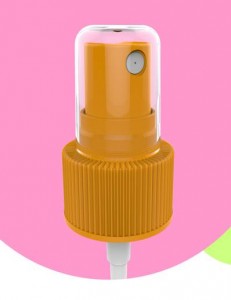
The spray pump, also known as the sprayer, is the main supporting product for cosmetic containers and one of the content dispensers. It uses the principle of atmospheric balance to spray the liquid in the bottle by pressing. The high-speed flowing liquid will also drive the gas flow near the nozzle, making the speed of the gas near the nozzle increase and the pressure decrease, forming a local negative pressure area. As a result, the surrounding air is mixed into the liquid to form a gas-liquid mixture, which makes the liquid produce an atomization effect
Manufacturing process
1.Molding process
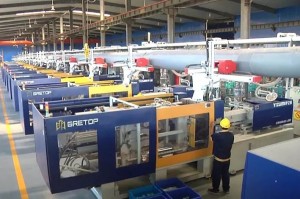
The bayonet (semi-bayonet aluminum, full-bayonet aluminum) and screw on the spray pump are all plastic, but some are covered with an aluminum cover and an electroplated aluminum. Most of the internal parts of the spray pump are made of plastic materials such as PE, PP, LDPE, etc., and are molded by injection molding. Among them, glass beads, springs and other accessories are generally purchased from outside.
2. Surface treatment
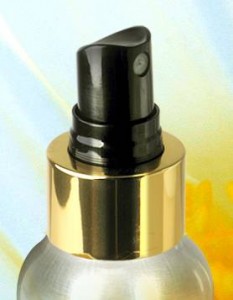
The main components of the spray pump can be applied to vacuum plating, electroplating aluminum, spraying, injection molding and other methods.
3. Graphics processing
The spray pump's nozzle surface and the surface of the braces can be printed with graphics, and can be operated using hot stamping, silk screen printing and other processes, but in order to keep it simple, it is generally not printed on the nozzle.
Product structure
1. Main accessories
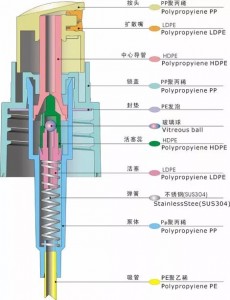
The conventional spray pump is mainly composed of a nozzle/head, a diffuser nozzle, a central conduit, a lock cover, a gasket, a piston core, a piston, a spring, a pump body, a straw and other accessories. The piston is an open piston, which is connected to the piston seat to achieve the effect that when the compression rod moves upward, the pump body is open to the outside, and when it moves upward, the studio is closed. According to the structural design requirements of different pumps, the relevant accessories will be different, but the principle and the ultimate goal are the same, that is, to effectively take out the contents.
2. Product structure reference
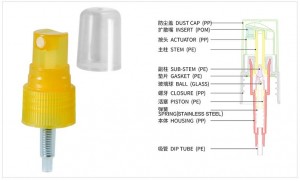
3. Water discharge principle
Exhaust process:
Assume that there is no liquid in the base working room in the initial state. Press the pressing head, the compression rod drives the piston, the piston pushes the piston seat down, the spring is compressed, the volume in the working room is compressed, the air pressure increases, and the water stop valve seals the upper port of the water pumping pipe. Since the piston and the piston seat are not completely closed, the gas squeezes the gap between the piston and the piston seat, separates them, and the gas escapes.
Water absorption process:
After exhausting, release the pressing head, the compressed spring is released, pushing the piston seat up, the gap between the piston seat and the piston is closed, and the piston and the compression rod are pushed up together. The volume in the working room increases, the air pressure decreases, and it is close to vacuum, so that the water stop valve opens the air pressure above the liquid surface in the container to press the liquid into the pump body, completing the water absorption process.
Water discharge process:
The principle is the same as the exhaust process. The difference is that at this time, the pump body is full of liquid. When the pressing head is pressed, on the one hand, the water stop valve seals the upper end of the water pipe to prevent the liquid from returning to the container from the water pipe; on the other hand, due to the compression of the liquid (incompressible fluid), the liquid will break the gap between the piston and the piston seat and flow into the compression pipe and out of the nozzle.
4. Atomization principle
Since the nozzle opening is very small, if the pressure is smooth (i.e., there is a certain flow rate in the compression tube), when the liquid flows out of the small hole, the liquid flow rate is very large, that is, the air at this time has a large flow rate relative to the liquid, which is equivalent to the problem of high-speed airflow impacting water droplets. Therefore, the subsequent atomization principle analysis is exactly the same as the ball pressure nozzle. The air impacts large water droplets into small water droplets, and the water droplets are refined step by step. At the same time, the high-speed flowing liquid will also drive the gas flow near the nozzle opening, making the speed of the gas near the nozzle opening increase, the pressure decreases, and a local negative pressure area is formed. As a result, the surrounding air is mixed into the liquid to form a gas-liquid mixture, so that the liquid produces an atomization effect
Cosmetic application
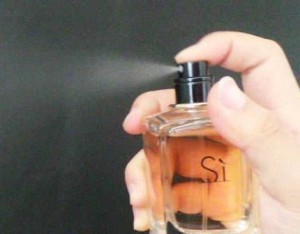
Spray pump products are widely used in cosmetic products,
Such as perfume, gel water, air fresheners and other water-based, essence products.
Purchasing precautions
1. Dispensers are divided into two types: tie-mouth type and screw-mouth type
2. The size of the pump head is determined by the caliber of the matching bottle body. The spray specifications are 12.5mm-24mm, and the water output is 0.1ml/time-0.2ml/time. It is generally used for packaging of products such as perfume and gel water. The length of the pipe with the same caliber can be determined according to the height of the bottle body.
3. The method of nozzle metering, the dosage of the liquid sprayed by the nozzle at one time, has two methods: peeling measurement method and absolute value measurement method. The error is within 0.02g. The size of the pump body is also used to distinguish the measurement.
4. There are many spray pump molds and the cost is high
Product display
Post time: May-27-2024


